aceofspadeshq at gee mail.com
CBD:
cbd.aoshq at gee mail.com
Buck:
buck.throckmorton at protonmail.com
joe mannix:
mannix2024 at proton.me
MisHum:
petmorons at gee mail.com
J.J. Sefton:
sefton at cutjibnewsletter.com
Saturday Gardening Thread: Butterflies Are Free and Other Stuff [Y-not, KT, and Weirddave]
Y-not: Good afternoon, Gardeners!
Inspired by KT's description of the butterfly-friendly milkweed plant, today's thread is brought to you by Puccini's Madame Butterfly which premiered in 1904:Set in Nagasaki, Japan, Madame Butterfly told the story of an American sailor, B.F. Pinkerton, who marries and abandons a young Japanese geisha, Cio-Cio-San, or Madame Butterfly. In addition to the rich, colorful orchestration and powerful arias that Puccini was known for, the opera reflected his common theme of living and dying for love. This theme often played out in the lives of his heroines -- women like Cio-Cio-San, who live for the sake of their lovers and are eventually destroyed by the pain inflicted by that love. Perhaps because of the opera's foreign setting or perhaps because it was too similar to Puccini's earlier works, the audience at the premiere reacted badly to Madame Butterfly, hissing and yelling at the stage. Puccini withdrew it after one performance. He worked quickly to revise the work, splitting the 90-minute-long second act into two parts and changing other minor aspects. Four months later, the revamped Madame Butterfly went onstage at the Teatro Grande in Brescia. This time, the public greeted the opera with tumultuous applause and repeated encores, and Puccini was called before the curtain 10 times. Madame Butterfly went on to huge international success, moving to New York's Metropolitan Opera in 1907.If at first you don't succeed... Take it away, KT:
Personal Gardening Update:
We got a little bit of rain! Yay! Later, a strange storm cell came through with sudden wind, lightning and maybe some hail nearby but no rain for us. It reminded me that there were some REAL storm cells in other parts of the country. Hope everybody's garden made it through the storms. Last year at this time, we had ripe Apriums on the tree. This year, they are just starting to color. I need to do more thinning of stone fruits. We are starting to see spider mites, despite the somewhat cooler (than last year) weather the past month. Spider mites were a real problem last year. I picked my first ripe Sungold tomato. Very nice flavor. Skin was a little tough, but that is to be expected in the first tomatoes of the year. The tomato plants look happier than our tomato plants the last couple of years. We planted them in a different location, so rotation may have helped. We also planted earlier. I had fun with the Garden Train video that Beverly linked in the comments a couple of weeks ago. I thought it was worth featuring today in case you missed it.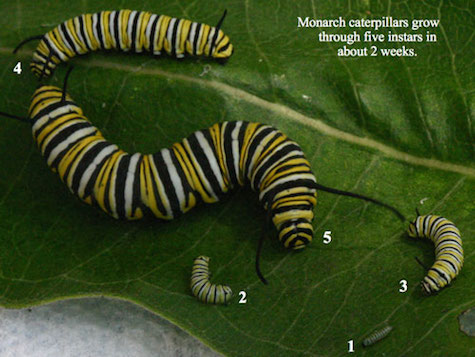
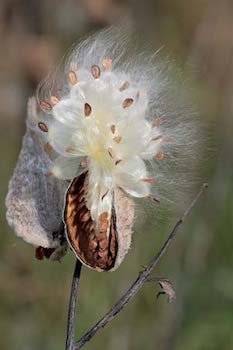
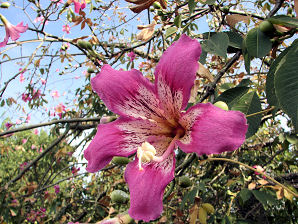


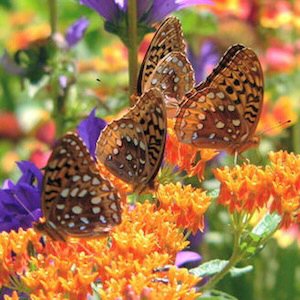

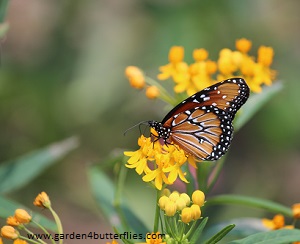

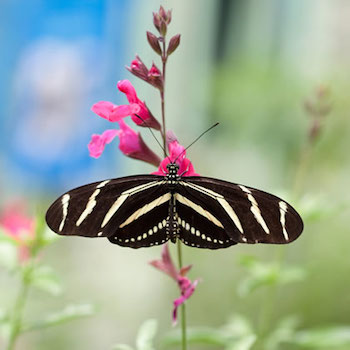

A butterfly's iridescent coloring is a result of the intricate patterning of thousands of microscopic scales, attached to thin wing membranes. Those scales scatter light in complex ways. Iridescence helps butterflies elude predators.

Each complex scale is made up of about 40 ribs, the ribs are connected by tiny cross bars.For a sense of scale, the yellow line below the scanning electron micrograph image is about 20 microns. A human red blood cell is roughly 8 microns in diameter.
The ribs are held apart by intricate crossbars. Air spaces also affect light absorption and refraction. Butterfly scales are composed of stacked chitin lamellae. Chitin is a tough, semitransparent substance that is the main component of the exoskeletons of arthropods, such as the shells of crustaceans and the outer coverings of insects. Chitin is also found in the cell walls of certain fungi and algae.This article from Wired explains more about the origins of the shine in butterfly wings, including a short video explaining how a particular butterfly's wings get their blue color:
A Butterfly scales' structural grid diffracts or bends light in different degrees and that interference is what gives butterflies their intensity of color, vibrancy and iridescence. When light hits the complex wing, the multiple reflections compound one another, such as when light hits a scale, that ray of light also interacts with light bouncing off the scale, in this case from numerous differing angles. These compound interactions create iridescence and variety of color.
Butterfly wings receive their color from two sources, from structural color (described above) and ordinary (or pigmented) color. Butterfly scales are also pigmented. Most brown and yellow butterflies get their color from melanin, just like you and I. Even Blue Morphos have a base of melanin. Melanin absorbs light which helps to further intensify a butterfly's coloration. Other coloring agents are uric acid (white), carotenoid pigments (orange) and flavonoids such as quercetin (red and purple).
Two kinds of cells are involved; scale cells and socket cells. In a caterpillar, they are just ordinary cells, and don't have any distinguishing characteristics. But early on in pupal development (7% complete), they begin to organize in rows corresponding to where the future wing will grow. Each butterfly scale is the product of a single scale cell.One correction to the text. The protein molecule that builds the long struts is called G-actin (for globular actin), not F-actin. G-actin is a round(ish) molecule, roughly 5 nanometers in diameter, that self-assembles into long actin filaments (F-actin). There are a battery of protein molecules and other chemical factors that regulate the assembly and disassembly of actin filaments in all of your cells and, as it turns out, in butterfly wings. Biology is cool. Small biology is really cool. Really small biology is...
The socket cell anchors the scale to the membrane of the insects' wing; the scale cell pokes through the insect's wing surface like a hernia. The scale cell forms strings of proteins called F-actins, which provides a framework on which the detailed nanostructures of the scales are built. At 28% complete metamorphosis, you can see both cells and ribbed bundles of actins forming. It's a ghostly outline of the scale structure to come.
Like a pasta maker, the scale cell squeezes out and assembles a lattice of actins. These actins form the template on which the rest of the scale's cuticle will be laid down, and foreshadow the fine ribs of the finished scale. At around 64% of the way through metamorphosis, the actin bundles begin to disappear, and the finishing touches are added to the scale. Eventually, the scale cell dies, revealing the finished scale which hardens upon emergence.
What's happening in your gardens this week?
**Post updated to point out the pro-life link.**
Comments
(Jump to bottom of comments)Posted by: Weirddave at May 23, 2015 01:50 PM (WvS3w)
And I'd probably manage to kill that, too.
Jim
Sunk New Dawn
Galveston, TX
Posted by: Jim at May 23, 2015 01:51 PM (7x4lH)
Well, demolition on the place is going to start soon, and my wife and the local boy scouts spent the morning digging up plants in their parking lot and culled about (she says) 200 pounds of bulbs.
These will get replanted around our town as part of the beautification program.
Posted by: Pappy O'Daniel at May 23, 2015 01:53 PM (oVJmc)
--
That's a great project!
Posted by: Y-not at May 23, 2015 01:54 PM (RWGcK)
Posted by: Y-not at May 23, 2015 02:02 PM (RWGcK)
The mulch bags are clear on one side and almost completely black on the other and at least 10 - 15 degrees warmer then air --- which is running a range of 55-70 lately.
Posted by: SE Pa Moron at May 23, 2015 02:05 PM (xQX/f)
---
The first two varieties of tomatoes that I planted are not happy campers. It's been very wet and cool. I just put in some of those Cherokee black plants which were successful last year. 'Hoping our weather cooperates.
Posted by: Y-not at May 23, 2015 02:07 PM (RWGcK)
Posted by: Ronster at May 23, 2015 02:11 PM (r124R)
Posted by: SE Pa Moron at May 23, 2015 02:05 PM
One thing that was discovered in recent years is the color red will accelerate tomato growth. I bought some red water tents and the tomatoes I use them on do get bigger faster.
Things have grown fast here in the last week or so. Got plenty of rain but It's amazing how dry the ground is already. Had to water everything yesterday.
Posted by: Farmer at May 23, 2015 02:12 PM (3hlFs)
Posted by: Garrett at May 23, 2015 02:13 PM (6qXZG)
Posted by: Truly St. Cyr at May 23, 2015 02:13 PM (WygWf)
Posted by: Turd Ferguson at May 23, 2015 02:14 PM (VAsIq)
"Swamp Milkweed, Asclepias incarnata" was intended to be the heading for the following section. Sorry, Y-not.
Posted by: KT at May 23, 2015 02:15 PM (qahv/)
Posted by: KT at May 23, 2015 02:15 PM (qahv/)
Question for the group: Could we plant them and keep them in an unheated garage over the winter to protect them from the critters? A sunny window is available and they can be watered as needed.
Any thoughts?
Posted by: JTB at May 23, 2015 02:16 PM (FvdPb)
Posted by: Garrett
Milkweed comes from Cowweed. Poison Ivy grows where Batman has been.
Posted by: I'm not a botanist but I play one on TV at May 23, 2015 02:17 PM (VAsIq)
Do you know which cultivars you planted?
Posted by: KT at May 23, 2015 02:18 PM (qahv/)
I just planted a half acre of peaches and corn as winter feed for my pigs, two of the smallest pigs decided they didn't care about the electric fence and ate about half the seed. They just re dug the furrow with their nose and got every seed. Tomorrow I turn those two into meat. Monday I replant. Pigs must respect the fence. It's a rule. If you are very tasty, don't break the rules.
If you want to see my garden check twitter. So far we've gotten potatoes, squash, cukes, and lettuce.
Oh, we had a close call with a tornado, less than a mile from our house.
Posted by: traye at May 23, 2015 02:19 PM (VveEI)
Posted by: Ronster at May 23, 2015 02:19 PM (r124R)
Posted by: Y-not on the phone at May 23, 2015 02:21 PM (itP1/)
Posted by: Bruce But Not Jenner at May 23, 2015 02:27 PM (iQIUe)
it might be possible to plant garlic in an unheated garage. Some people plant shallots inside and harvest the greens.
Have you looked into whether you could plant some garlic cultivars in the spring? There is one called "Susanville" that I doubt would do much growing over winter in Susanville. Don't know how it does in warm climates.
But here's some information on spring planting:
http://www.gardenguides.com/99045-plant-garlic-spring.html
Posted by: KT at May 23, 2015 02:28 PM (qahv/)
Posted by: JTB at May 23, 2015 02:31 PM (FvdPb)
You can also "hill up" your gangly beans with some of your planting mix to stabilize the stems. Don't try this with your broccoli or brussels sprouts, though.
Posted by: KT at May 23, 2015 02:34 PM (qahv/)
Posted by: boulder terlit hobo at May 23, 2015 02:34 PM (UemZn)
Posted by: Bruce But Not Jenner
Spider silk. From spiders. That fall from the sky.
Posted by: Turd Ferguson at May 23, 2015 02:34 PM (VAsIq)
Couple nights ago I saw three deer about 150 feet away - downwind. I picked up my jar of coyote urine, flipped open the spout and all I saw was white tails bolting. Stuff really works. Before they would ignore me completely, then graze all night long on everything.
Posted by: SE Pa Moron at May 23, 2015 02:36 PM (xQX/f)
Posted by: JTB at May 23, 2015 02:36 PM (FvdPb)
Posted by: lowandslow at May 23, 2015 02:40 PM (dItuC)
Swamp milkweed, purple coneflower, parsley, bronze fennel, blazing star and phloxes sound like a fine start. You might look for a local guide to which butterflies live in your area.
Swallowtail caterpillars are beautiful on bronze fennel once they get past the bird dropping look-alike stage. In the West, Anise Swallowtails mostly live near hills and/or canyons. In the East, you can get Black Swallowtails over a wider area.
Posted by: KT at May 23, 2015 02:41 PM (qahv/)
Posted by: Ronster at May 23, 2015 02:42 PM (r124R)
Posted by: traye at May 23, 2015 02:42 PM (VveEI)
It might get run over :^/
Posted by: boulder terlit hobo at May 23, 2015 02:42 PM (UemZn)
Posted by: Trotsky w/an icepick in his head at May 23, 2015 02:46 PM (LaZ5x)
Posted by: Ronster at May 23, 2015 02:47 PM (r124R)
Carefully, I imagine.
Me, I just punch some keys and Amazon delivers. At the rate I'm using it the six buck bottle should last about a year. Worth every penny. I have thousands of plants, most deer-proof, a lot not so.
Posted by: SE Pa Moron at May 23, 2015 02:47 PM (xQX/f)
Posted by: KT at May 23, 2015 02:49 PM (qahv/)
Best news of the day? I didn't have to show ID at wallyworld to buy a box of shotgun shells! That was a surprise.
Posted by: chi's sandwIch (previously shredded chi) at May 23, 2015 02:49 PM (ILmoZ)
Posted by: boulder terlit hobo at May 23, 2015 02:50 PM (UemZn)
Posted by: chi's sandwIch
*takes note*
Posted by: NSA Agent Assigned to AoS at May 23, 2015 02:51 PM (VAsIq)
And I'm pretty sure that poster is pro-abortion, not pro-life, but that's not something to argue in a garden thread.
Posted by: Weirddave at May 23, 2015 02:52 PM (sqMPm)
Well, most of 'em. They've spread!
We're over 30 inches of rain for this year, with more forecast for the next several days.
Red River is expected to reach flood stage next week.
Hard to get any work done with all the rain, and even when it's not raining, it's very wet and sooo buggy.
Posted by: Mama AJ at May 23, 2015 02:52 PM (0xTsz)
"I assume that raccoons don't like to be hailed on, at least."
Can only speak for myself, but being caught outside in a hail storm is no fun at all.
Posted by: HH at May 23, 2015 02:54 PM (Ce4DF)
Posted by: Ronster at May 23, 2015 02:56 PM (r124R)
Posted by: Truly St. Cyr at May 23, 2015 02:56 PM (WygWf)
My goodness.
The blackberries have spread out faster than poison ivy this year!
I'll have buckets full before long!
Posted by: chi's sandwIch (previously shredded chi) at May 23, 2015 02:57 PM (ILmoZ)
Posted by: KT at May 23, 2015 03:03 PM (qahv/)
Posted by: Ronster
When I was 3 my grandpa shot a possum and buried it, I checked every day for a possum plant.
Posted by: traye at May 23, 2015 03:04 PM (VveEI)
http://tinypic.com/r/5js01j/8
Sulphur burner for the blueberries. I asked. It goes into the water somehow.
Posted by: CaliGirl at May 23, 2015 03:05 PM (BHl9S)
Posted by: traye at May 23, 2015 03:06 PM (VveEI)
Posted by: CaliGirl at May 23, 2015 03:07 PM (BHl9S)
I love those monarchs but despite my humongous milkweed garden, they lay enough eggs to mow the thing down repeatedly. I can't keep up! They have the most beautiful colored cocoons. It looks unreal with those golden highlights!
That was the most fantastic lesson on milkweeds, KT! I spent a ton of time researching this stuff when we found a couple monarchs with funky wings and that parasite is what some websites talked about. I planted some of the native kinds but not nearly the success of the pretty orange and yellow non native ones.
I also plant a ton of borage to keep the bees happy.
All in all a great garden week.
Posted by: keena at May 23, 2015 03:09 PM (RiTnx)
I see I was too late for the previous thread.
Posted by: Bob's House of Flannel Shirts and Wallet Chains at May 23, 2015 03:09 PM (yxw0r)
What do I use for fertilizer for amyrillias bulbs outside. They are in pots. They are just finishing blooming.
Posted by: CaliGirl at May 23, 2015 03:10 PM (BHl9S)
Also, the fig tree (more like a fig twig) is fully leafing out. I am beyond amazed that the little thing survived the winter. May have to move it to a bigger container in a year or so.
Posted by: JTB at May 23, 2015 03:10 PM (FvdPb)
Let us know if you get more caterpillars on the parsley or the bronze fennel.
Around here, if I want native plants other than weeds, I have to plant them. Some native butterfly plants, like stinging nettle, most people don't want in their yards.
Sometime we probably ought to mention tree choices for attracting butterflies.
I just bought some Profusion zinnias (mildew resistant, single) and some marigolds for the butterflies. I'm keeping the cherry, white and apricot zinnias from the mix and giving the orange ones to a neighbor.
I'm not doing much planting because of the drought. The lantana is blooming, though.
Posted by: KT at May 23, 2015 03:14 PM (qahv/)
I have a tomato in my bed that must have self seeded as well. I love surprises.
Posted by: CaliGirl at May 23, 2015 03:14 PM (BHl9S)
Posted by: Cruzinator at May 23, 2015 03:14 PM (8cSVB)
Posted by: KT at May 23, 2015 03:17 PM (qahv/)
Posted by: Y-not on the phone at May 23, 2015 03:20 PM (RWGcK)
got the old concrete post bottoms from the back neighbors fence what blew down dug out with my trusty digging bar
and now I've got to stop until i get a building permit.
all in all not bad
Posted by: Bigby's Knuckle Sandwich at May 23, 2015 03:20 PM (8i7dG)
Posted by: Truly St. Cyr at May 23, 2015 03:22 PM (WygWf)
Posted by: Lea at May 23, 2015 03:23 PM (G1u1h)
Lettuce, peas, and blackberries!
And my wildflowers continue to mock me. The plants got huge, just look like overgrown weeds. Now they are finally blooming, but one at a time, so it still mostly looks like weeds with a few flowers...and then a few flowers of a different color.
Posted by: Mama AJ at May 23, 2015 03:24 PM (0xTsz)
I think you can just fertilize your amaryllis bulbs with regular balanced houseplant fertilizer. Are you growing Naked Ladies - the pink ones - or florist's amaryllis (hippeastrum, the kind people get for Christmas gifts)?
Posted by: KT at May 23, 2015 03:28 PM (qahv/)
The largest PowerBall jackpot ever won was $590.5 million, 2 years ago by Gladys MacKenzie, who was 85 years old. Hope she is still enjoying her filthy lucre.
Posted by: Bruce But Not Jenner at May 23, 2015 03:29 PM (iQIUe)
Posted by: Velvet Ambition at May 23, 2015 03:30 PM (R8hU8)
Posted by: Polliwog the 'Ette at May 23, 2015 03:32 PM (GDulk)
Posted by: Velvet Ambition
At least you joined--I haven't gotten around to even that part yet.
Posted by: Turd Ferguson at May 23, 2015 03:35 PM (VAsIq)
Yes, digging up bushes and trees can be a real challenge. Were they dead or alive?
In our neighborhood, a house was just re-built, and the contractors took out a palm tree with a backhoe. They are especially difficult to cut down, but the plant is dead once the top is gone.
Posted by: KT at May 23, 2015 03:36 PM (qahv/)
Posted by: KT at May 23, 2015 03:39 PM (qahv/)
Posted by: Y-not at May 23, 2015 03:39 PM (RWGcK)
Once I sized a narrow bed next to a fence to fit over an off-the-shelf roll of hardware cloth. Made it from cinder blocks, lined with plastic. No tools necessary except scissors to cut the plastic.
Posted by: KT at May 23, 2015 03:43 PM (qahv/)
Posted by: KT at May 23, 2015 03:44 PM (qahv/)
Posted by: KT at May 23, 2015 03:46 PM (qahv/)
--------------------
BOO..., HISS..., BOOOOOO
Posted by: Mike Hammer, etc., etc. at May 23, 2015 03:48 PM (n6Nt0)
http://tinypic.com/r/v4qijt/8
The one that isn't growing was from Christmas. The others my husband got from the seed company. I don't know which they are.
Posted by: CaliGirl at May 23, 2015 03:49 PM (BHl9S)
---
I may do that.
It's raining here again. Very wet here. Ugh.
Posted by: Y-not at May 23, 2015 03:49 PM (RWGcK)
Posted by: Ronster at May 23, 2015 03:51 PM (xElWh)
Posted by: Mike Hammer, etc., etc. at May 23, 2015 03:52 PM (n6Nt0)
Heh.
Posted by: KT at May 23, 2015 03:52 PM (qahv/)
It's been raining almost the entire month of May.
Posted by: Old Blue at May 23, 2015 03:54 PM (9iR5/)
tomato plants staked.
http://tinypic.com/r/2hojpc4/8
My husband doesn't want me pull any because we aren't selling them. He doesn't want any hurt feelings. The guy in charge of this ranch thinks they are OK. I will post more pics as they progress.
Posted by: CaliGirl at May 23, 2015 03:54 PM (BHl9S)
Posted by: KT at May 23, 2015 03:58 PM (qahv/)
Looks like the tomatoes might be set up for Florida Weave support. Air circulation isn't as big an issue in your area as it is in more humid areas, so maybe the close spacing won't matter too much.
Posted by: KT at May 23, 2015 04:03 PM (qahv/)
Posted by: CaliGirl at May 23, 2015 04:04 PM (BHl9S)
Posted by: KT at May 23, 2015 04:06 PM (qahv/)
Thanks, I will check the pots. My husband just brings this stuff home and I don't know anything. The seed salesman will bring a box to the office and everyone takes some.
Posted by: CaliGirl at May 23, 2015 04:07 PM (BHl9S)
Posted by: Eromero at May 23, 2015 04:07 PM (go5uR)
Posted by: KT at May 23, 2015 04:07 PM (qahv/)
Posted by: CaliGirl at May 23, 2015 04:08 PM (BHl9S)
My zone is 9b
Posted by: CaliGirl at May 23, 2015 04:11 PM (BHl9S)
Posted by: fluffy at May 23, 2015 04:17 PM (Ua6T/)
I live very close to the Monarch groves in Nipomo and pismo beach. We went there with Girl Scouts. I drive by those all the time.
Posted by: CaliGirl at May 23, 2015 04:19 PM (BHl9S)
Posted by: KT
I've been in the woods in the southeast my entire life (46) never seen a wild quail. Until here. I've seen them several times, stomping through the woods and had them fly up, just couldn't get a good enough look to see what it was. Then the other day I saw one run out of a little clump of deep grass at a field margin so I got a good look. So looking back I've probably jumped them at least ten times since last September. Also, started specifically listening for them, yep, they are there, every evening and morning. I'd imagine they really like my pig field, it's deep cover with lots of grain and grass seed heads.
Posted by: traye at May 23, 2015 04:28 PM (VveEI)
Posted by: Ronster at May 23, 2015 04:31 PM (xElWh)
The quail are around the chicken coop. They put the nests on the ground in bushes. They run and fly away when I get near. I petted them. My guy had the female resting in the palm of his hand. It could have flown away, but didn't. This guy handles the bees as well. He has a green thumb as well. It is called a hot hand in Spanish.
Posted by: CaliGirl at May 23, 2015 04:32 PM (BHl9S)
You amaryllis should go dormant sometime in the summer. They come from a dry summer-wet winter climate.
True Amaryllis (Naked Ladies) bloom while they are dormant, so they have no leaves when the flowers bloom.
I have been to the butterfly grove near Pismo. It is really something to see. I've also seen Monarchs fly out over the ocean near Los Osos. Their navigation systems seemed to be slightly off. Some were coming back inland.
Posted by: KT at May 23, 2015 04:38 PM (qahv/)
Posted by: Y-not at May 23, 2015 04:38 PM (RWGcK)
Posted by: stace at May 23, 2015 04:38 PM (CoX6k)
Posted by: KT at May 23, 2015 04:40 PM (qahv/)
Posted by: Ronster at May 23, 2015 04:40 PM (xElWh)
I have never seen them in Los Osos. They are magnificent. I haven't went to the groves in a long time.
Posted by: CaliGirl at May 23, 2015 04:42 PM (BHl9S)
Posted by: Y-not at May 23, 2015 04:43 PM (RWGcK)
Posted by: Ronster at May 23, 2015 04:46 PM (xElWh)
I will watch for that. Thanks for the help, I appreciate it.
Posted by: CaliGirl at May 23, 2015 04:46 PM (BHl9S)
Posted by: JTB at May 23, 2015 04:56 PM (FvdPb)
Those fritillaries really chew up the passionvines every year, but I think they're worth it. The leaves seem to grow back pretty fast.
Posted by: stace at May 23, 2015 05:05 PM (CoX6k)
Posted by: Sambo at May 23, 2015 05:09 PM (0Txm0)
Flowers are gorgeous though!
Posted by: FCF at May 23, 2015 05:32 PM (kejii)
Sometime we probably should do a segment on the Fritillaries and their relatives here. Have you ever seen a Zebra Longwing, like the one in the photo Y-not posted? Their caterpillars eat passionvines, too. I thing the chrysalis of the Variegated Fritillary is especially interesting.
Passionvines can be invasive. Watch that their roots don't go where they are not wanted.
Posted by: KT at May 23, 2015 05:53 PM (qahv/)
Popular city for music. Mills Brothers here:
Back in Nagasaki where the brothers chew tabaccy. . . . .
https://www.youtube.com/watch?v=y61mL66lwcQ
Posted by: KT at May 23, 2015 06:13 PM (qahv/)
I do see the zebra longwings around here, but I didn't know they use the passionvine too. I had to google that variegated fritillary,and that is a cool looking chrysalis.
Posted by: stace at May 23, 2015 06:14 PM (CoX6k)
Posted by: KT at May 23, 2015 06:16 PM (qahv/)
Posted by: JTB at May 23, 2015 04:56 PM
Very true, it's about enjoying the journey, not just getting to the destination.
Posted by: Farmer at May 23, 2015 06:23 PM (o/90i)
Didn't work, I was just out to check
Either I mixed wrong, I didn't pump hard enough or the chemical is now spoiled.
I'm going to have to get a real pump and sprayer and get a boom built. *sigh*
Posted by: Kindltot at May 23, 2015 06:55 PM (t//F+)
Sambo,
Only way I know of is to go to the archives in the lower right corner of the main page, then go to each Saturday afternoon - one by one.
It's worth the trouble. Lots of good stuuf from smart people here...
Posted by: chi's sandwIch (previously shredded chi) at May 23, 2015 07:19 PM (BISbA)
Plus, she posted a video with Maria Callas singing Puccini. Pretty impressive.
Posted by: KT bar the door at May 23, 2015 07:59 PM (qahv/)
Didn't work, I was just out to check
Either I mixed wrong, I didn't pump hard enough or the chemical is now spoiled.
I'm going to have to get a real pump and sprayer and get a boom built. *sigh*
Posted by: Kindltot at May 23, 2015 06:55 PM
Roundup or any form of gy...whatever is very dependent on the weather. Plants have to be very actively growing. Warm enough and wet enough so they aren't dormant.
I'm a fool, tried to get a jump on things and sprayed when it was too cold. Damn weeds survived and had to spray again.
Posted by: Farmer at May 23, 2015 09:08 PM (o/90i)
Processing 0.02, elapsed 0.0226 seconds.
15 queries taking 0.0088 seconds, 128 records returned.
Page size 97 kb.
Powered by Minx 0.8 beta.
Real Clear Politics
Gallup
Paul Anka Haiku Contest Announcement
Integrity SAT's: Entrance Exam for Paul Anka's Band
AllahPundit's Paul Anka 45's Collection
AnkaPundit: Paul Anka Takes Over the Site for a Weekend (Continues through to Monday's postings)
George Bush Slices Don Rumsfeld Like an F*ckin' Hammer
Democratic Forays into Erotica
New Shows On Gore's DNC/MTV Network
Nicknames for Potatoes, By People Who Really Hate Potatoes
Star Wars Euphemisms for Self-Abuse
Signs You're at an Iraqi "Wedding Party"
Signs Your Clown Has Gone Bad
Signs That You, Geroge Michael, Should Probably Just Give It Up
Signs of Hip-Hop Influence on John Kerry
NYT Headlines Spinning Bush's Jobs Boom
Things People Are More Likely to Say Than "Did You Hear What Al Franken Said Yesterday?"
Signs that Paul Krugman Has Lost His Frickin' Mind
All-Time Best NBA Players, According to Senator Robert Byrd
Other Bad Things About the Jews, According to the Koran
Signs That David Letterman Just Doesn't Care Anymore
Examples of Bob Kerrey's Insufferable Racial Jackassery
Signs Andy Rooney Is Going Senile
Other Judgments Dick Clarke Made About Condi Rice Based on Her Appearance
Collective Names for Groups of People
John Kerry's Other Vietnam Super-Pets
Cool Things About the XM8 Assault Rifle
Media-Approved Facts About the Democrat Spy
Changes to Make Christianity More "Inclusive"
Secret John Kerry Senatorial Accomplishments
John Edwards Campaign Excuses
John Kerry Pick-Up Lines
Changes Liberal Senator George Michell Will Make at Disney
Torments in Dog-Hell
The Ace of Spades HQ Sex-for-Money Skankathon
A D&D Guide to the Democratic Candidates
Margaret Cho: Just Not Funny
More Margaret Cho Abuse
Margaret Cho: Still Not Funny
Iraqi Prisoner Claims He Was Raped... By Woman
Wonkette Announces "Morning Zoo" Format
John Kerry's "Plan" Causes Surrender of Moqtada al-Sadr's Militia
World Muslim Leaders Apologize for Nick Berg's Beheading
Michael Moore Goes on Lunchtime Manhattan Death-Spree
Milestone: Oliver Willis Posts 400th "Fake News Article" Referencing Britney Spears
Liberal Economists Rue a "New Decade of Greed"
Artificial Insouciance: Maureen Dowd's Word Processor Revolts Against Her Numbing Imbecility
Intelligence Officials Eye Blogs for Tips
They Done Found Us Out, Cletus: Intrepid Internet Detective Figures Out Our Master Plan
Shock: Josh Marshall Almost Mentions Sarin Discovery in Iraq
Leather-Clad Biker Freaks Terrorize Australian Town
When Clinton Was President, Torture Was Cool
What Wonkette Means When She Explains What Tina Brown Means
Wonkette's Stand-Up Act
Wankette HQ Gay-Rumors Du Jour
Here's What's Bugging Me: Goose and Slider
My Own Micah Wright Style Confession of Dishonesty
Outraged "Conservatives" React to the FMA
An On-Line Impression of Dennis Miller Having Sex with a Kodiak Bear
The Story the Rightwing Media Refuses to Report!
Our Lunch with David "Glengarry Glen Ross" Mamet
The House of Love: Paul Krugman
A Michael Moore Mystery (TM)
The Dowd-O-Matic!
Liberal Consistency and Other Myths
Kepler's Laws of Liberal Media Bias
John Kerry-- The Splunge! Candidate
"Divisive" Politics & "Attacks on Patriotism" (very long)
The Donkey ("The Raven" parody)
